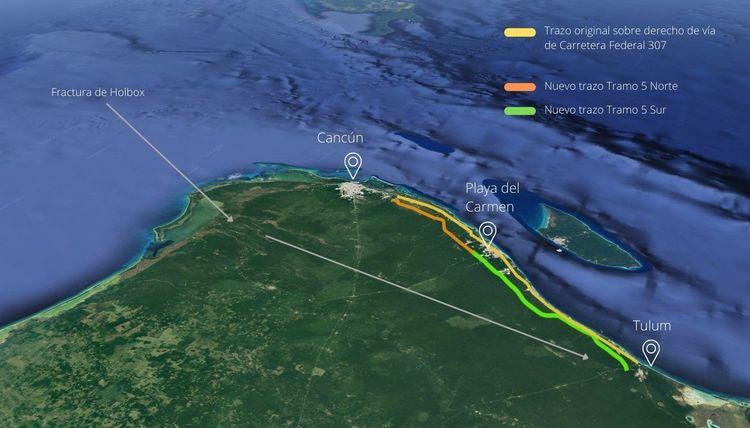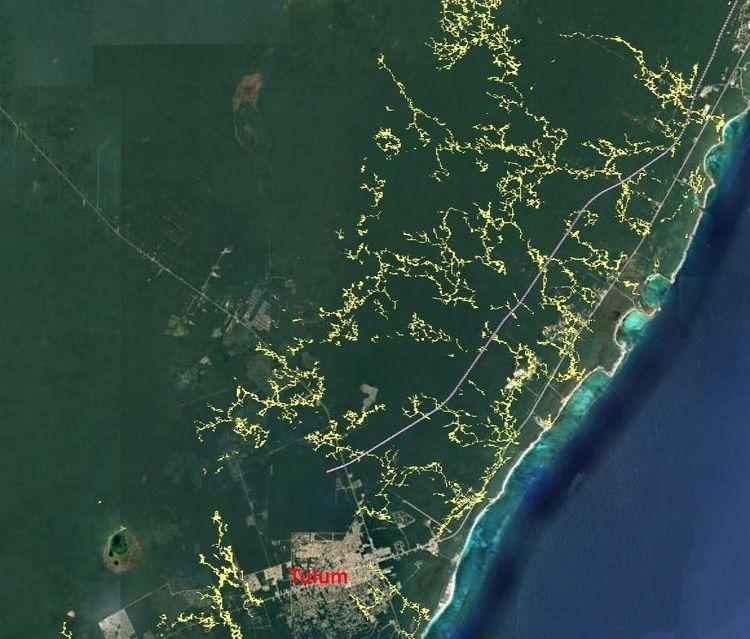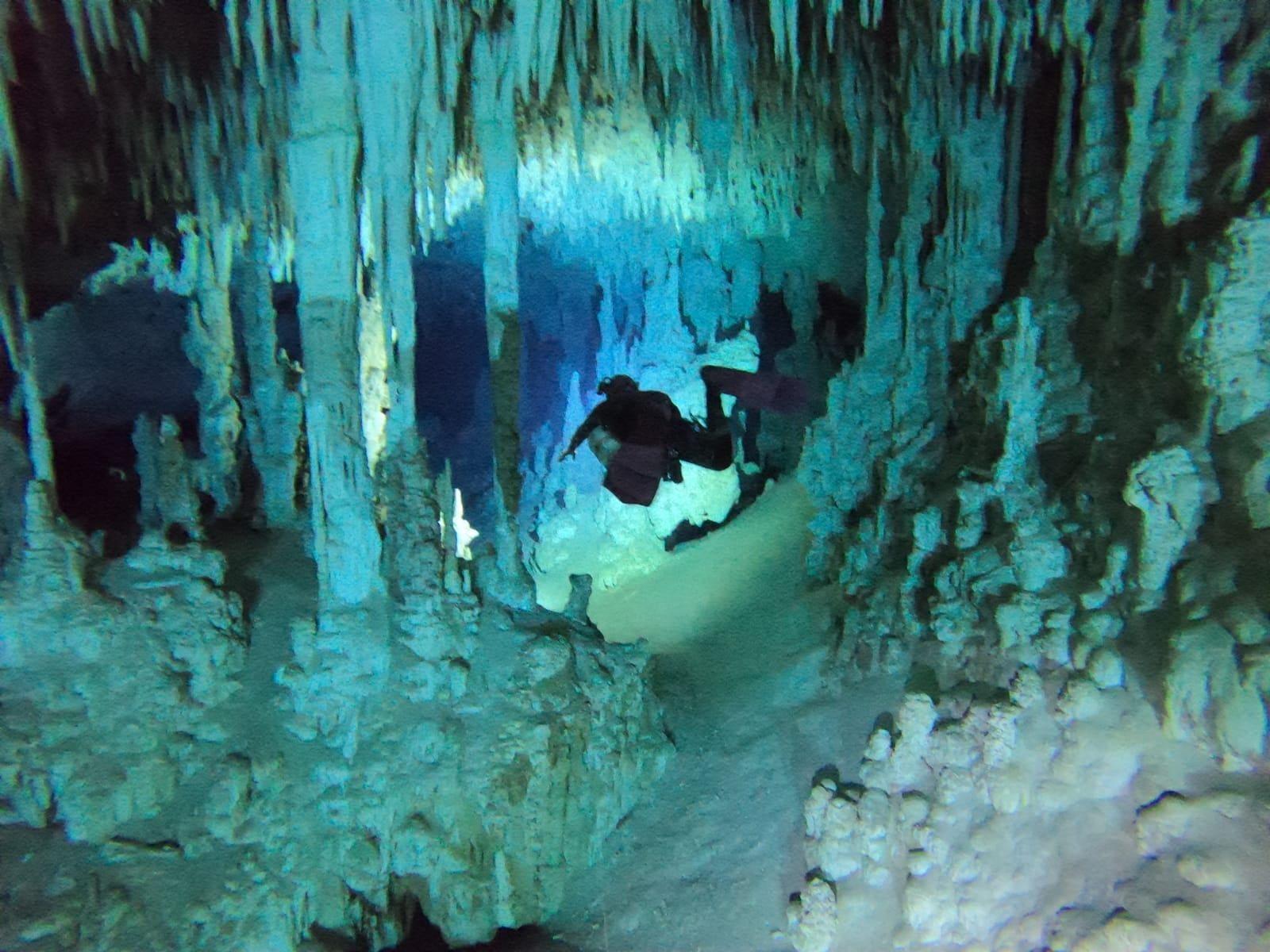The decision of the Mexican government to change the track route on section 5 of the Maya Train, which runs from Cancun to Tulum, in the state of Quintana Roo, has sparked a wave of criticism from the environmental community, who see potential risks for the Great Maya Aquifer.
Civil society organizations, service providers, divers and experts launched a series of pronouncements over the past week against the modification of the project, which is now expected to pass over an area where cenotes, underground caves and caverns abound.
The original project of Section 5, presented by the National Fund for Tourism Promotion (Fonatur) in 2019, contemplated running along the central road of Federal Highway 307, which connects the tourist destinations of Cancun, Puerto Morelos, Playa del Carmen and Tulum.
However, at the end of January, after a restructuring of Fonatur, the new owner, Javier May, announced changes to the original plan: instead of the road, the road will enter the virgin jungle, according to the plan presented to the owners of the properties where the work will cross, to which Journalism Causa Natura had access.
The Yucatan Peninsula has a type of karst soil composed of limestone rock and an underground aquifer a few meters deep. The soil in the region is like Gruyère cheese, said Roberto Rojo, a member of the Mayab Speleological Circle.
“The implications of building a train on or upstream of karst terrain are the imminent collapses, the possible contamination and irremediable degradation of this aquifer,” reads a statement signed by 37 specialists and 20 civil society organizations.
Alejandro López Tamayo, hydrogeologist and director of Centinelas del Agua A.C., details that one of the main characteristics of karst soils is their composition of limestone rock, which dissolves with water. Therefore, he adds, these are unstable soils, hence the common subsidence and sinkholes in urban areas.
“If we increase the load on an underground cave system that has a limited roof, with a smaller thickness, the destruction of these sites is much more feasible. It is also likely that they will be filled in, as is the common practice that has been given,” he said.
Section 5 South, between Playa del Carmen and Tulum, is the area of greatest concern. The train, which is expected to run at a speed of 150 kilometers per hour, will pass over the Dos Ojos-Sac Actún system, the largest flooded underground cave in the world. Rojo, who is also a master of science, states that this is a highly relevant area because it is the connection between the Holbox Fracture and the Caribbean Sea.

Photo: Special
The Fracture is a geological fault that concentrates a range of ecosystems such as jungles, sheets, mangroves, cenotes and underground rivers, which runs from the northwest of Quintana Roo to the central area.
“Everything that rains in the Holbox Fracture area has to drain into the Caribbean Sea, then it drains through underground rivers. These rivers run from East to West and the route of the Mayan Train is from North to South, so that the route is going to thunder the systems of several of these underground rivers,” he said.
Acciona/Grupo México, the winning consortium of the construction tender for section 5 Sur, presented land owners, including the Playa del Carmen and Jacinto Pat ejidos, with construction solutions consisting of the installation of a system of concrete piles between the subsoil and the surface, to support the structure of the roads.
“If you have to set up piles every 10 or 20 meters, it doesn't matter if there's a cave underneath. Given the number of underground rivers, the systems are going to thunder,” he added.

Photo: Roberto Rojo
Entrepreneurs and service providers, with divided opinions
The change of route of Section 5 of the Maya Train was applauded, in principle, by the main business organizations of the Riviera Maya, since months before they formalized this request to President Andrés Manuel López Obrador, on the grounds that doing so by road would generate multiple complications on other roads, mainly on the Cancun-Playa del Carmen section, which often suffers from traffic jams.
However, other tourism sectors have joined the disgruntled group. The Regional Committee for Speleodiving, Ecology and Regulation, together with the Association of Aquatic Service Providers of the Riviera Maya, the Caribbean Divers Union and the Tulum Cenotes and Sea Diving collective, expressed their rejection of the proposal in a joint statement.
“Nature tourism and, in particular, tourism related to visiting cenotes, represents one of the main sources of income in this region. An important segment of the population of the Riviera Maya depends directly on this activity,” they said.
Luis Leal, diving instructor and one of the most prominent explorers of the Dos Ojos-Sac Actún system, said that the construction plans pose a risk to the local economy. “Cenote-related activities, which are so iconic in Quintana Roo, are threatened because they intend to pass through a train in the middle of the main cenote areas,” he said.
Section 5: No environmental studies or permits
On January 17, 2022, the Secretariat of Agrarian, Territorial and Urban Development (Sedatu) issued the Declaration of Public Utility for 198 private properties located in the municipalities of Benito Juárez, Puerto Morelos, Solidaridad and Tulum, to be used for the construction of Section 5 of the Maya Train.
Fonatur set a preliminary route for the passage of the train. One day before the publication of the Declaration, on January 16, each owner was given a document to be signed, giving permission for Train personnel to enter the terrain to carry out measurements, perforations and corresponding technical studies.
The General Law on Ecological Balance and Environmental Protection (Lgeepa) establishes in its article 28 public or private works subject to the obligation to submit an Environmental Impact Statement (MIA) for prior evaluation.
When it comes to works related to roads, railways or projects that alter hydrological basins, the developer must submit an application for authorization from MIA-Regional to the Secretariat of Environment and Natural Resources (Semarnat).
However, Fonatur does not have such authorization to start works on this Section since the request has not been entered into the processing system, as recorded in the records of the Ecological Gazette.
The Maya Train project only has environmental permits in the first phase of the project, that is, in Sections 1, 2 and 3.
With regard to Section 4, where significant progress has been made in the works, there is no authorization regarding Environmental Impact either, because although the MIA was admitted, it is in a “suspended status for additional information”.
Causa Natura Journalism sought an interview with Fonatur, the agency responsible for the execution of the Maya Train project, to learn their position regarding the publication. The Communication Coordination reported that the institution is unable to provide information, due to the ban due to the Revocation of Mandate consultation process.



Comentarios (0)